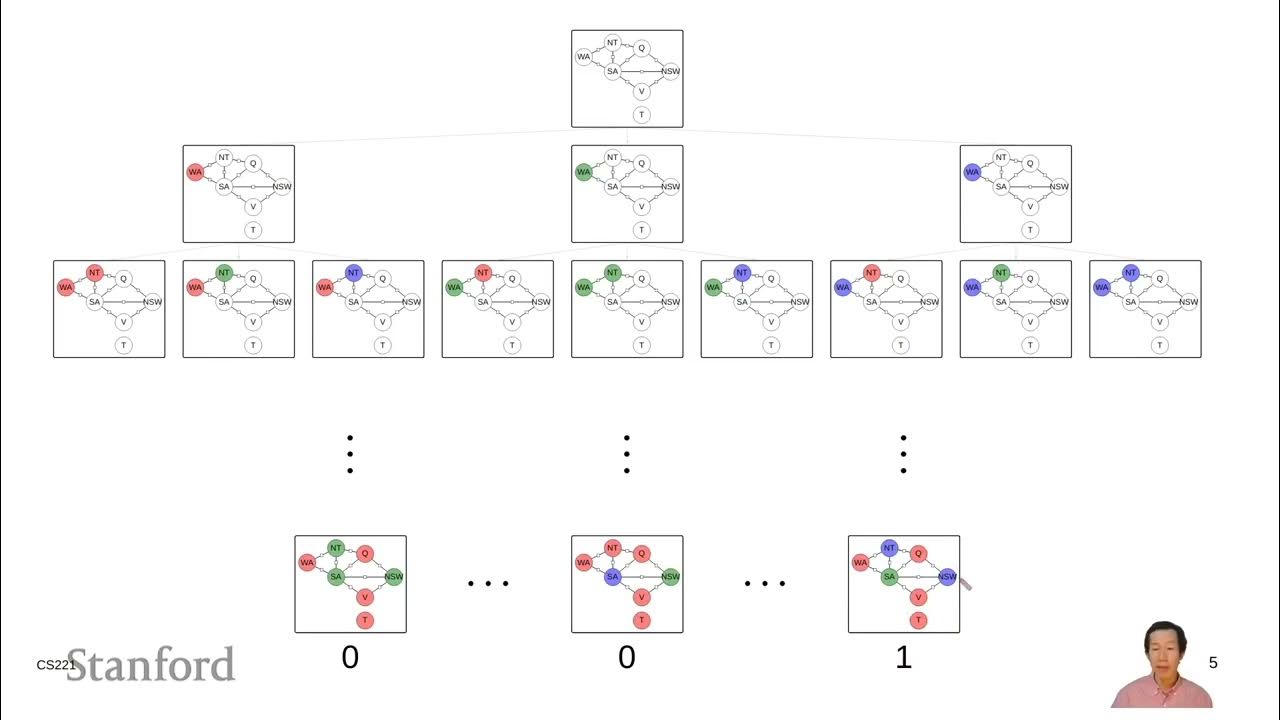Constraint Satisfaction: the AC-3 algorithm
Summary
TLDRThe AC-3 algorithm simplifies constraint satisfaction problems by ensuring arc consistency among variables. It transforms binary constraints into arcs, creating pairs that facilitate checking the relationships between variables. By iteratively processing these arcs, the algorithm prunes inconsistent values from the domains of variables, ensuring that every variable has possible values that meet the constraints. Through a systematic approach, including checking and updating arcs, the AC-3 algorithm effectively reduces the complexity of CSPs, making them easier to solve with standard methods like backtracking.
Takeaways
- 😀 The AC-3 algorithm simplifies constraint satisfaction problems by enforcing arc consistency through the relationships between variables.
- 🔗 Each binary constraint creates two directed arcs, treating the left and right sides of constraints differently.
- 📋 The algorithm begins by generating arcs for all binary constraints in the problem.
- 🗂️ An agenda is used to manage the processing of arcs, allowing the algorithm to systematically check each constraint.
- 🔍 For each arc, the algorithm checks if every value in the left variable has a corresponding valid value in the right variable.
- ✂️ If a value in the left variable does not satisfy the constraint, it is pruned from its domain.
- 🔄 When a domain is changed, arcs involving the modified variable on the right side must be revisited for re-evaluation.
- ⚙️ The process continues until the agenda is empty, indicating that the problem is arc consistent.
- 📊 Achieving arc consistency simplifies the CSP, making it easier to solve with methods like backtracking.
- 🌍 The AC-3 algorithm has practical applications in AI, robotics, and game development, particularly in scheduling and resource allocation.
Q & A
What is the purpose of the AC-3 algorithm?
-The AC-3 algorithm simplifies constraint satisfaction problems by using constraints to prune values from the domains of variables, making the problem easier to solve.
How does the AC-3 algorithm treat binary constraints?
-The algorithm transforms binary constraints into arcs, creating two directed relationships for each constraint. For example, the constraint 'A ≠ B' results in arcs 'A ≠ B' and 'B ≠ A.'
Why are arcs important in the AC-3 algorithm?
-Arcs are important because they allow the algorithm to check the relationships between variables efficiently and to prune values from their domains based on the constraints.
What does the algorithm do when it finds a value in a variable that cannot satisfy the constraints?
-If a value in a variable cannot be paired with a valid value from another variable, that value is pruned from the variable's domain.
What happens to the agenda during the execution of the AC-3 algorithm?
-The agenda holds the arcs to be processed. If a variable's domain changes during the pruning process, arcs involving that variable are added back to the agenda for further checking.
Can you describe the initial setup of the example used in the script?
-In the example, three variables are defined: A can take values {1, 2, 3}, B can take values {1, 2, 3}, and C can take values {1, 2, 3}, with the constraints that A must be greater than B and B must equal C.
How does the algorithm handle the arc 'A > B' in the example?
-When processing the arc 'A > B,' the algorithm checks each possible value of A to see if there is a corresponding valid value of B that meets the constraint. If no valid value exists, it prunes that value from A's domain.
What is the significance of pruning in the context of the AC-3 algorithm?
-Pruning is significant because it reduces the search space by removing inconsistent values from the variable domains, leading to a more manageable and solvable problem.
What indicates that the AC-3 algorithm has completed its process?
-The algorithm completes when the agenda is empty, which means all arcs have been processed and the problem is now arc-consistent.
How does achieving arc consistency benefit solving constraint satisfaction problems?
-Achieving arc consistency simplifies the CSP by ensuring that all variables have potential values that can satisfy the constraints, making it easier to apply methods like backtracking to find a solution.
Outlines

Этот раздел доступен только подписчикам платных тарифов. Пожалуйста, перейдите на платный тариф для доступа.
Перейти на платный тарифMindmap

Этот раздел доступен только подписчикам платных тарифов. Пожалуйста, перейдите на платный тариф для доступа.
Перейти на платный тарифKeywords

Этот раздел доступен только подписчикам платных тарифов. Пожалуйста, перейдите на платный тариф для доступа.
Перейти на платный тарифHighlights

Этот раздел доступен только подписчикам платных тарифов. Пожалуйста, перейдите на платный тариф для доступа.
Перейти на платный тарифTranscripts

Этот раздел доступен только подписчикам платных тарифов. Пожалуйста, перейдите на платный тариф для доступа.
Перейти на платный тарифПосмотреть больше похожих видео

Section 1 Worksheet Solutions: CSPs

CS3491 AIML – Constraint Satisfaction Problem (CSP) with Example in tamil

Introduction to Constraint Satisfaction Problems (CSP)

Constraint Satisfaction Problems (CSPs) 2 - Definitions | Stanford CS221: AI (Autumn 2021)

Constraint Satisfaction Problems (CSPs) 1 - Overview | Stanford CS221: AI (Autumn 2021)

Lezione: la scelta del consumatore, il paniere ottimo.
5.0 / 5 (0 votes)
